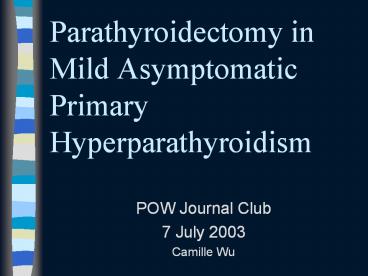Parathyroidectomy in Mild Asymptomatic Primary Hyperparathyroidism - PowerPoint PPT Presentation
1 / 18
Title:
Parathyroidectomy in Mild Asymptomatic Primary Hyperparathyroidism
Description:
Parathyroidectomy in Mild Asymptomatic Primary Hyperparathyroidism POW Journal Club 7 July 2003 Camille Wu Clinical Question Symptomatic parathyroid disease with ... – PowerPoint PPT presentation
Number of Views:83
Avg rating:3.0/5.0
Title: Parathyroidectomy in Mild Asymptomatic Primary Hyperparathyroidism
1
Parathyroidectomy in Mild Asymptomatic Primary
Hyperparathyroidism
- POW Journal Club
- 7 July 2003
- Camille Wu
2
Clinical Question
- Symptomatic parathyroid disease with significant
hypercalcaemia - Vs
- Asymptomatic parathyroid disease with mild
hypercalcaemia - Role of parathyroidectomy
3
Search History
- Hyperparathyroidism or primary hyperthyroidism or
Hypercalcaemia - Parathyroidectomy or surgery
- 1 and 2 limit to RCT
4
Paper identified
- Randomized trial of parathyroidectomy in mild
asymptomatic primary hyperparathyroidism Patient
description and effects on the SF-36 health
survey - Gary Talpos, Henry G Bone III, Michael
Kleerekoper, et al - Surgery, 1281013-21, Dec 2000
5
Method - recruitment
- Patients referred to Henry Ford Hospital April
1994 March 1997 - Eligibility and Exclusion criteria applied
- Baseline history, examination and investigations
and SF-36 Health Survey - Repeated every 6 months
6
SF-36 Health Survey
- Physical functioning
- Social functioning
- Role functioning physical
- Role functioning emotional
- Mental health
- Vitality
- Body pain
- General health perception
- Health Change
7
Method arms of study
- Block randomisation into operative or
non-operative (observation) groups - Operative group
- Operation within 4 weeks of randomisation
- Single surgeon
- Standard parathyroidectomy bilateral approach
- Removal of all enlarged glands
8
Method - analysis
- Baseline laboratory and medical history variables
- Univariate analyses
9
Method - analysis
- Tabulation of results
- Success of outcome
- Incidence of persistent disease
- Incidence of resistant disease
- Number and weight of involved glands
- Complications of surgery
- Non-operative group patients requiring surgery
for new symptoms - Change over time measures on SF-36
10
Results
- 53 patients
- 25 operative group (2 refused op)
- 28 non-operative group (3 later required
operations) - Female preponderence (42F 11M)
- Both groups balanced
- Op group older than non-op (66.7 vs 62.6)
- Follow-up rate 100
11
Results and Discussion
- Multigland disease in 6/26 (23)
- Weight of glands
- range 0.080g to 9.58g
- No post-operative complications
12
Results and Discussion
- No persistent hypercalcaemia or raised PTH levels
post-op and for gt 1 year - Despite multigland disease
- Normalisation of Ca2 and PTH levels ascribed to
bilateral approach
13
Results and Discussion
- Recurrence of hyperparathyroidism in 2/26
operated patients at slightly over one year
post-op - Attributed to high rate of multigland disease
- Unknown if recurrence rate will increase with
time
14
Results and Discussion
- Number of non-operative patients developing
symptoms and requiring operation is 3/28 (11) - Reflects nature of disease?
- Or bias due to close monitoring?
15
Results
- SF-36 favoured operative group on 2 scales
- Social functioning plt0.07
- Role functioning (emotional) plt0.12
- ? Detects patients at preclinical stage before
physical changes occur and symptoms develop
16
Conclusion of study
- First RCT displaying significant improvement in
SF-36 result - Supports parathyroidectomy soon after diagnosis
of primary hyperparathyroidism - Ethical problem with sham surgery comparison
group - Further studies
17
Critical Appraisal
- Randomised controlled trial
- Not blinded - possible placebo effect
- ? block randomisation
- Study population all within 100 mile radius of
downtown Detroit relevance to local population - Intention to treat analysis
- 100 follow-up
18
Critical Appraisal
- SF-36 Survey
- Subjective? But tested
- Statistical significance translating to clinical
significance - 2/9 domains improved - ? significance
- 6/9 domains worse but not statistically
significant































